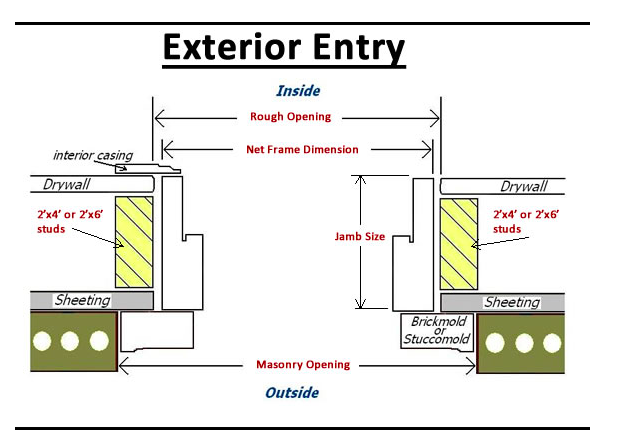When considering doors, most people focus on the panel, the knob, or the hinges. However, one of the most essential yet often overlooked components is the door jamb. This foundational element plays a crucial role in the stability, functionality, and aesthetics of a door system. Whether you’re a homeowner, a builder, or simply curious about how doors work, understanding door jambs can offer surprising insights into architectural design and structural integrity.
What is a Door Jamb?
A door jamb is the vertical portion of the door frame onto which a door is secured. It’s the part of the frame that supports the hinges on one side and often the strike plate for the latch or lock on the other. The term “jamb” can also refer to the entire frame assembly, including both vertical sides and the top horizontal piece, known as the head jamb or lintel.
Components of a Door Jamb
To better understand the role of a door jamb, let’s break down the elements that are typically included:
- Hinge jamb: The vertical side where the door’s hinges are mounted.
- Strike jamb: The opposite side, where the door latch or bolt engages with the frame.
- Head jamb: The top horizontal component of the frame.
- Threshold or sill: The bottom part, often found in exterior doors, providing a seal and transition between interior and exterior spaces.
- Stop molding: A narrow strip of wood attached to the jamb that prevents the door from swinging too far.
Importance of the Door Jamb
Despite its humble appearance, the door jamb serves several critical functions:
1. Structural Support
The door jamb helps transfer the weight of the door to the wall structure, ensuring that the door operates smoothly and remains aligned. Without a sturdy jamb, doors would sag or become misaligned over time.
2. Security
In residential and commercial buildings, the door jamb is integral to security. It anchors the hinges and the strike plate, which absorbs the force when a door is closed or locked. Reinforcing door jambs is often recommended for enhanced burglary protection.
3. Weather Resistance
Exterior door jambs, in combination with weather stripping and thresholds, help seal the doorway against drafts, rain, dust, and insects. A compromised jamb can lead to energy inefficiency and damage from the elements.
4. Aesthetics
The door jamb contributes to the visual appeal of the doorway. When properly installed and finished, it blends seamlessly with trim and molding to create a polished look.
Types of Door Jambs
Door jambs vary depending on the type of door, its location, and the materials used. Here are the most common types:
1. Wooden Jambs
Wood is the most traditional material for door jambs. It is easy to work with and finish but can be susceptible to rot, insects, and warping if not properly treated or maintained.
2. Metal Jambs
Steel or aluminum jambs are often used in commercial buildings or high-security applications. They offer superior strength and durability but are more difficult to modify or repair.
3. Composite or PVC Jambs
These synthetic materials are resistant to moisture, rot, and termites, making them ideal for exterior use or in damp environments like bathrooms or basements.
4. Split Jambs
These come in two pieces and are designed to fit into walls of varying thicknesses. The two halves sandwich the wall and casing, making installation easier and more adaptable.
Installation and Alignment
Proper installation of a door jamb is crucial for door performance. Here are the key steps and considerations:
1. Plumb and Level
The jamb must be installed perfectly vertical (plumb) and horizontal (level) to ensure smooth operation of the door. Any misalignment can lead to rubbing, sticking, or uneven gaps.
2. Shimming
Shims are thin wedges of wood or plastic inserted behind the jamb during installation. They help adjust the position to achieve a perfect fit.
3. Fastening
Secure the jamb with screws or nails into the wall framing. It’s important to fasten through the shims to maintain the alignment.
4. Finishing
After installation, the gaps between the jamb and wall are filled with insulation or caulk and covered with trim molding. Paint or stain can be applied to match the surrounding decor.
Door Jamb Maintenance and Repair
Over time, door jambs may suffer wear and tear. Here’s how to handle common issues:
1. Loose Hinges
Tighten screws or replace them with longer ones to anchor into the wall framing.
2. Cracked Wood
Minor cracks can be filled with wood filler. Larger structural damage may require replacing the jamb section.
3. Rot and Moisture Damage
Especially in exterior jambs, check for soft spots or discoloration. Rotten sections must be cut out and replaced, followed by sealing and painting.
4. Security Reinforcement
Install a metal reinforcement plate or longer screws to fortify the jamb against forced entry.
Innovations and Trends in Door Jamb Design
While the basic function of the door jamb hasn’t changed in centuries, there have been some innovations in recent years:
- Adjustable Jamb Systems: These allow for easier installation in uneven or older walls.
- Integrated Weather Sealing: Modern jambs often come with built-in weather stripping channels.
- Smart Door Frames: Some high-tech jambs integrate sensors, locks, and even biometric systems for modern home security.
Common Misconceptions About Door Jambs
There are a few myths or misunderstandings about door jambs that are worth addressing:
- “The door jamb is the door.”
Not quite. The door is the movable panel. The jamb is part of the stationary frame that holds the door in place. - “All jambs are the same.”
Jambs vary significantly in material, size, and design based on usage, load, and environmental conditions. - “Door jambs are purely cosmetic.”
On the contrary, they are critical to the function and security of any door.
Conclusion
The door jamb may not be the most glamorous component of a home or building, but it is undoubtedly one of the most essential. It serves as the backbone of the door structure, providing support, security, and insulation. Understanding the design, materials, installation process, and maintenance of door jambs can make a significant difference in building performance and durability.
So, the next time you open or close a door, take a moment to appreciate the simple yet vital role played by the humble door jamb. It’s a small part of architecture that holds great responsibility—quietly doing its job day in and day out.




